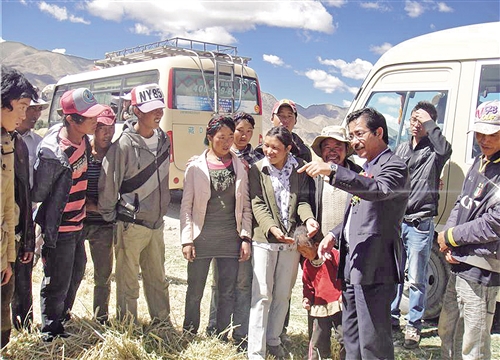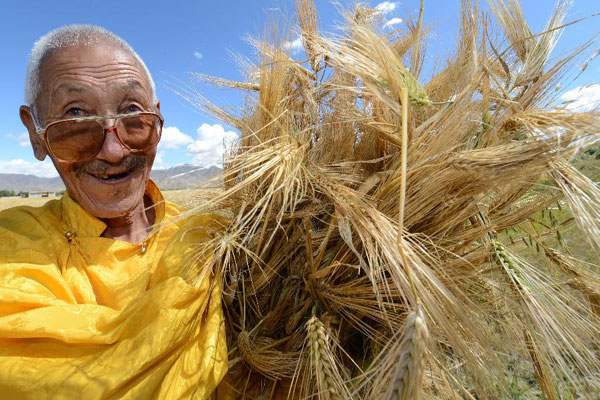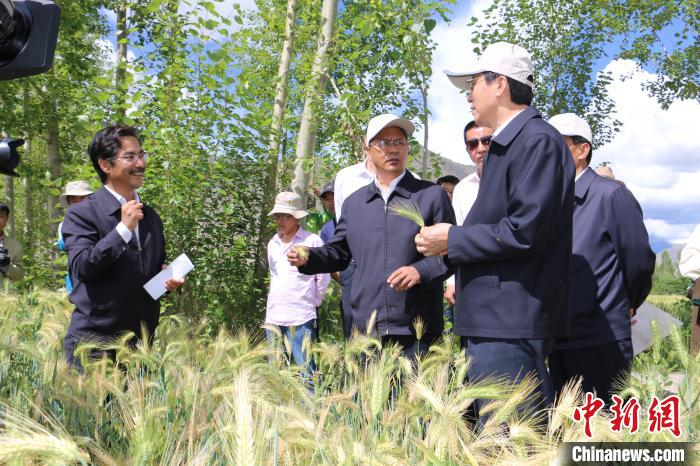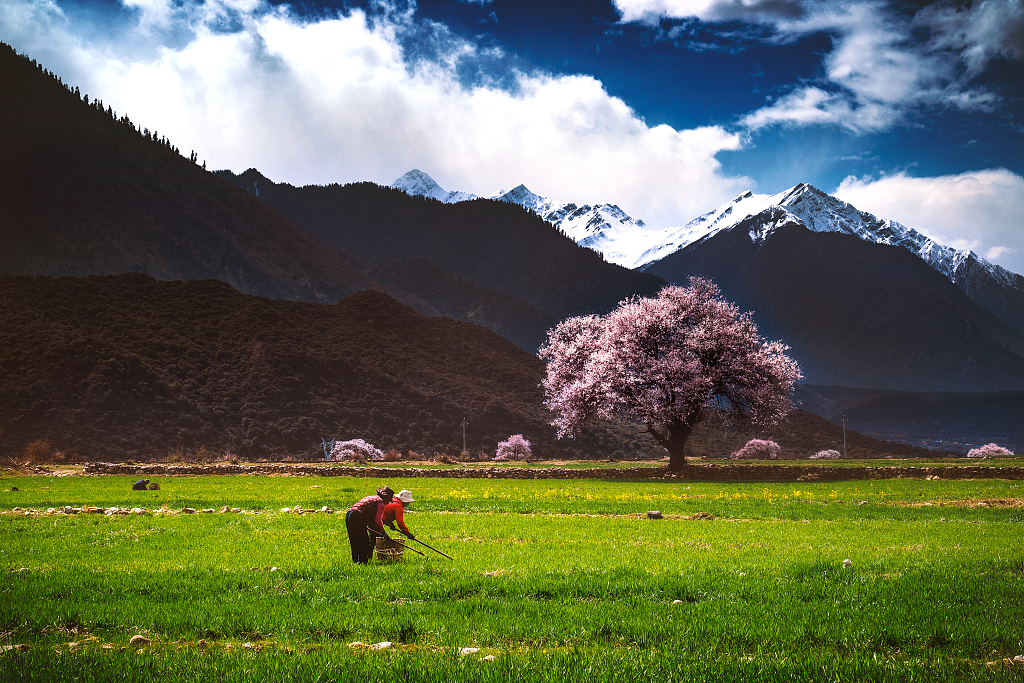Nutritionally rich, culturally significant and easy to prepare and carry about, tsamba, a staple dish in Tibet Autonomous Region made from roasted barley flour and pounded yak butter dissolved in warm buttered-tea, has long been ingrained in ancient lore and everyday life of Tibetan people.
It is an indispensable part of Tibetans' daily diets, as you may already know. But what you may not know is every bite of tsamba the Tibetans savor is the result of one man's scientific and technological contribution, while the smiling faces of local farmers at the bumper harvest are a reflection of his unremitting hard work and dedication.

Nyima Tashi (3rd R) explains the cultivation techniques of highland barley to local farmers. /Photo via Economic Daily
Nyima Tashi (3rd R) explains the cultivation techniques of highland barley to local farmers. /Photo via Economic Daily
He is Nyima Tashi, Tibet's chief scientist of highland barley crop breeding and the former head of the Tibet Academy of Agricultural and Animal Husbandry Sciences (TAAAS).
On September 5, 2020, he died in a car accident on a business trip to an agricultural research center in Ngari Prefecture, at the age of 55.
Widely known as Dr Barley, Nyima Tashi had committed himself to highland barley cultivation in Tibet for the past decades, finalizing the seed selection of over 20 new yet high-quality barley varieties in the region and introducing Tibetan farmers to the well-selected cultivars that would help them shake off poverty through increased income.
"Zangqing 2000" is one of the remarkable achievements of selective breeding conducted by Nyima Tashi and his team. The new variety proved to be a popular choice locally, and now accounts for more than half of the acreage of highland barley planted in Tibet. So far, the land under cultivation of the superior cultivar has yielded an output of 350 kilograms per mu (approximately 5,250 kg per hectare), achieving an additional output value of 398 million yuan (around $59.8 million).

A local farmer reaps a field under the cultivation of a variety of highland barley named "Zangqing 2000" in Bainang County, Shigatse Prefecture, southwest China's Tibet Autonomous Region, September 7, 2013. /Photo via Xinhua
A local farmer reaps a field under the cultivation of a variety of highland barley named "Zangqing 2000" in Bainang County, Shigatse Prefecture, southwest China's Tibet Autonomous Region, September 7, 2013. /Photo via Xinhua
Born into a rural family in Chanang County of Shannan City in 1966, Nyima Tashi always remembered the lack of highland barley available to eat, let alone tsamba. With the tough times deeply imprinted in his childhood memory, he desired to rid locals of starvation.
In 1982, 16-year-old Nyima Tashi was enrolled at Northwest Agriculture and Forestry University in China's Shaanxi Province, where he majored in agronomy. Upon graduation, he became a researcher engaged in scientific work at the TAAAS.
During those times, however, Nyima Tashi never stopped learning. In 1995, he was admitted to the successive postgraduate and doctoral program at the Institute of Geographical Sciences and Natural Resources Research at the Chinese Academy of Sciences, and four years later became the first Tibetan researcher with Doctor's degree of agricultural science since the region's peaceful liberation in 1951.
In the course of his postgraduate study, Nyima Tashi was once offered a job opportunity at the International Center for Integrated Mountain Development (ICIMOD) with a tempting salary of $2,500 per month, almost nine times higher than the amount he earned at the TAAAS. Nevertheless, he declined the offer resolutely, saying that he was "destined to return to Tibet" and that "the hopes his fellow folks placed on him with expectant faces were what really mattered to him."

Nyima Tashi (1st L) conducts research in an experimental field. /Photo via Chinanews.com
Nyima Tashi (1st L) conducts research in an experimental field. /Photo via Chinanews.com
The past decades witnessed not only Nyima Tashi's untiring pursuit of academic studies and research but also of highland barley breeding and plantation via countless experiments conducted with local farmers.
Every year, he spent five to six months in the experimental fields, meticulously observing crops through plowing, sowing, harvesting and threshing. Meanwhile, the go-getter made time to collect over 1,500 varied cultivars of highland barley that helped sort out the genetic map of Tibetan barley.
All the endeavors paid off. More and more high-quality and prolific varieties emerged as Nyima Tashi tried out hybrid combinations followed by further selection and breeding. The headway made by Nyima Tashi and his team, therefore, is considered instrumental to Tibet's total annual grain output exceeding 1 million tons in the near future, further improving the crop yield and benefiting millions of farmers on the plateau.

Tibetans plant highland barley in March 2018, Nyingchi, Tibet. /CFP
Tibetans plant highland barley in March 2018, Nyingchi, Tibet. /CFP
Since the launch of the Democratic Reforms in Tibet in 1959, the past six decades have seen a great leap forward in agriculture in the region, especially in the field of selective breeding. Altogether, 149 varieties of crops have been selected and bred, including 68 for highland barley, 53 for wheat, 25 for oilseed rape and three for potato. In addition, the planting area of highland barley in Tibet is reportedly expected to top 2.15 million mu (about 143,000 hectares) by the end of 2020.